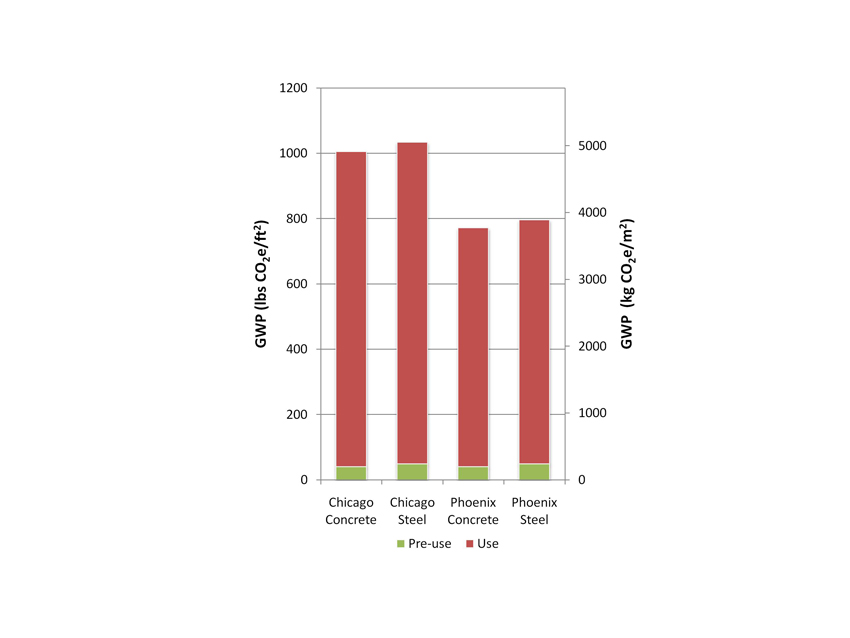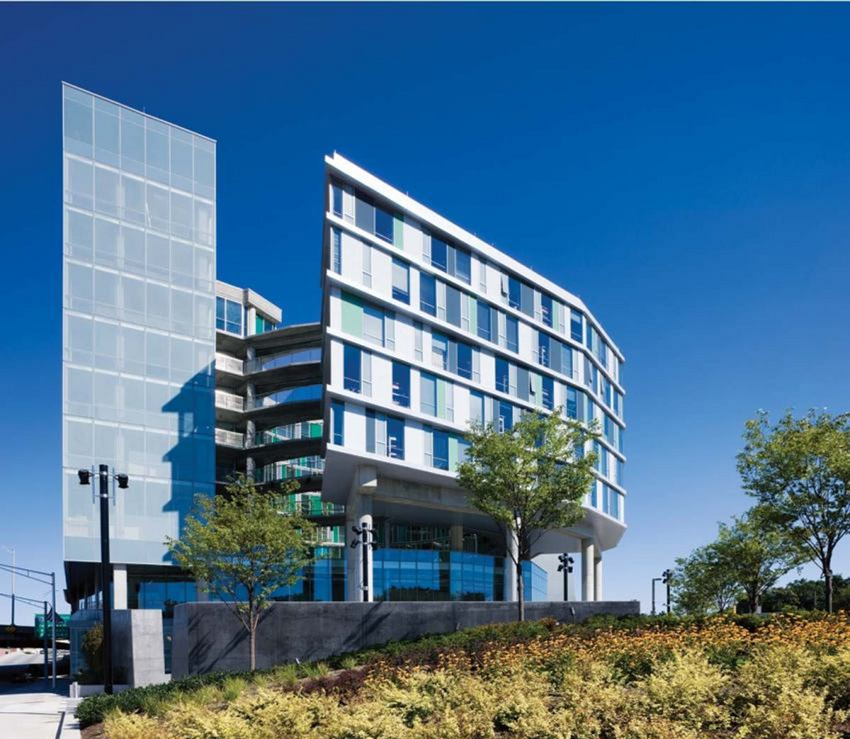Specifying Sustainable Concrete
Influence of Design Decisions
Although project specifications can affect the performance of a project, the single biggest influence an architect and engineer can have on the environmental impacts of a structure is through efficient design. The following are several factors that affect the performance of concrete and concrete structures:
Design loads: Every structure, at a minimum, must be designed to resist forces from gravity, service, wind, earthquakes, water, soil, fire, and blast, among others. If a structure does not meet these minimum requirements, it would be deemed unsafe and therefore unsustainable. Usually a structural engineer designs the structure to resist minimum loads prescribed in a building code. Alternatively, the owner can choose higher loading to resist natural disasters or other loading over and above the building code minimums. Having a structure that can resist disasters without suffering significant damage would be considered more sustainable. After all, a green building that is destroyed during a natural disaster will ultimately increase the environmental burden since the materials in the building (structure, fixtures, furnishings, etc.) will end up in landfills and the building will have to be rebuilt using new materials.
Structural efficiency: Regardless of the design loading, an architect’s and structural engineer’s objective is to design the structural system for optimized performance and minimize waste. There is no point in having a concrete mixture with low environmental impact if the structural member is overdesigned by 20 percent. Not only can efficient design lower the impact of the structural system, but it also tends to reduce the impacts of other materials. For example, minimizing the depth of the beams in the structure can significantly reduce the floor-to-floor heights of a building, thus leading to reduced quantity of exterior cladding and interior finishes, which can lower the environmental impacts of a building significantly.
Durability: A structure that needs constant maintenance and repair results in significant environmental impact. Structures that are exposed to harsh environments must be designed appropriately to resist deterioration. For concrete, this usually means consideration of freezing and thawing cycles, abrasion, chlorides (from road salt or marine environments), or sulfates (contained in soil or water). A combination of good design detailing along with durable concrete mix designs can result in a durable concrete structure. Appropriate concrete cover, corrosion-resistant reinforcement, low-permeability concrete, effective use of SCMs, chemical admixtures that improve corrosion resistance, surface coverings, and crack control are all potential strategies for providing a durable concrete structure. As discussed above, design professionals should assign exposure classes to concrete based on the severity of the anticipated exposure of the structural concrete members. The building code provides specific requirements for concrete mixtures to resist various levels of exposure. In most cases, the requirements are performance based, thus eliminating the need for engineers to specify additional prescriptive criteria.
Constructability: Design decisions can also affect constructability. Smaller members with congested reinforcement take more time and energy and are typically more costly to construct. A project specification that requires a minimum quantity of fly ash greater than normal use could result in delayed strength gain that could add to the construction schedule since floors might not be able to be post-tensioned within a reasonable time frame or a bridge deck might not be able to open to traffic without significant delays. A project specification with a maximum limit on slag cement could result in concrete used for massive members to produce high heat of hydration and significant cracking. A project specification that limits slump to a certain value could result in concrete that cannot be pumped efficiently or finished effectively. All of these consequences of prescriptive specification requirements could render the project unsustainable.
Energy efficiency: Concrete buildings are typically more energy efficient than lighter-framed buildings because of thermal mass. Thermal mass is a material’s ability to store heat and release it over time. There are three characteristics of thermal mass. First, the time lag between peak heating and cooling loads and outside temperature peaks is greater for massive buildings. This feature can be used in buildings by delaying the need for heating or cooling energy to take advantage of off-peak demand. In an office building, this means that heat gain can be delayed until everyone has gone home. Second, massive buildings have lower peak heating and cooling loads, allowing for smaller, more efficient heating and cooling equipment. And third, massive buildings require less overall heating and cooling energy to maintain the same interior temperatures since temperature swings are moderated.
In a research report published by the Massachusetts Institute of Technology (MIT), the effects of thermal mass were explored using LCA for a 12-story, 498,590-square-foot commercial building. The building was analyzed for a 60-year life for two climates, Phoenix and Chicago, and for two different structural materials, concrete and steel. The analysis demonstrated that the greenhouse gas emissions due to the operational energy of the building are responsible for 95–96 percent of life-cycle emissions. Figure 1 demonstrates that the concrete building has approximately the same embodied emissions as steel but lower operating emissions, which can lead to lower life-cycle emissions.

Figure 7: This graph shows the total global warming potential (GWP) over a 60-year lifespan for commercial buildings.
Aesthetics: An architect can specify concrete with color, shape, and texture for nearly any application. This distinguishes concrete from most other materials in the sense that the surface of concrete structural systems can be exposed on the interior or exterior of a building. This helps to reduce the need for additional finish material, thus reducing the environmental impact.

Figure 8: The Gateway at the Maryland Institute College of Art in Baltimore uses concrete to form distinctive circular structures sectioned into three pods of residential units surrounding a private central courtyard. The round shape of the residential wing, one of the building’s central features, was formed by a faceted cylinder elevated on slender concrete columns. Concrete balconies and walkways ring the interior of the hollow residential wing, providing basic circulation as well as vantage points for watching outdoor performances in the courtyard. The flexibility of concrete is on full display in the drum shape of the residential wing. Concrete structural slabs create both the support and shape that the building needs to achieve its unique design.
Conclusion
An environmentally conscious building owner is interested in a concrete structure that provides a long service life without significant defects and has a low environmental footprint—not necessarily how much cement the concrete contains. Using a performance specification, the concrete producer is free to select the mixture proportions and held responsible for meeting the performance criteria. Since performance specifications would allow for mixture optimization and adjustments during the project, there is an incentive for the designer and producer to collaborate for optimal mix technology. With a performance specification, a quality concrete producer can improve product quality, stimulate innovation, reduce construction cost, and minimize construction time—all while reducing environmental footprint.









